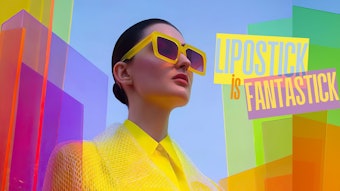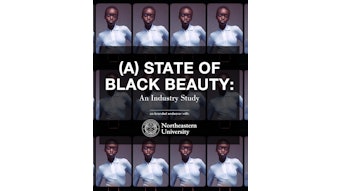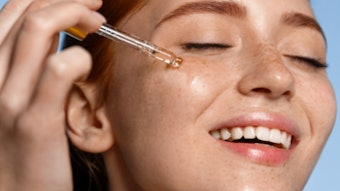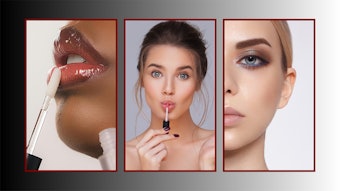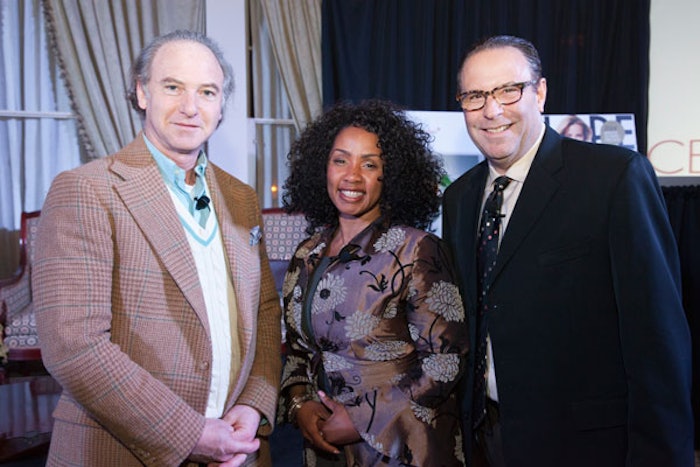
Testimonials, endorsements, and the Internet are all impacting purchase in today’s market, and while trends reveal a proclivity for classics and couture, the value equation is taking on nuances across all channels. These and other aspects of the market were revealed in a presentation held on February 6, 2014, at The Union League Club in New York City. Carlotta Jacobson, president, Cosmetic Executive Women, welcomed attendees to the presentation of the Women and Men in Beauty series—distinguished by CEW’s collaboration with The NPD Group, which tracks consumer behavior, retail trends, and both the mass and prestige markets.
The panel featured Karen Grant, vice president and global beauty industry analyst, The NPD Group; Marshal Cohen, chief industry analyst, fashion, The NPD Group; and Larry Levin, executive vice president, GTM practice leader, IRI Worldwide. Jenny Fine, WWD/Beauty Inc, moderated.
Grant began the presentation with an overview that highlighted key insights on the state of brick-and-mortar retail, bringing a revealing perspective on who is shopping and how, where and when they are doing so. She revealed that 57% of shoppers found deals online to be more attractive, and that sales in brick and mortar in the U.S. in some segments were lower than in online sales.
In addition, she noted another triumph for the online market with high-end makeup consumers, stating that this segment of shoppers are more Internet savvy, and 88% are more likely to seek out online beauty products. “Prestige beauty online is outpacing brick and mortar, and prestige beauty growth in the U.S. is outpacing mass,” said Grant. “This growth gap is seen across all categories.” She also noted the influence of product awards and other factors that have impacted online growth. Product reviews and testimonials appear to have the most influence on purchase decisions across all age and income groups. However, the amount of influence that third-party endorsements have on beauty shoppers tends to decrease with age. “Best of” awards have shown to have more influence on women in the $75K+ income group.
Grant noted that prestige beauty is up by +5% in the U.S. “Total beauty sales in 2013 were driven by cosmetics. Hand and body lotion were up +4.5%, and nails didn’t make it into the top five,” said Grant. In online performance, skin care sales were up +22%, and makeup sales online were up +17%. Notably, skin care drivers have changed, with primary care (including cleansing and hydration) outpacing anti-aging. Skin care has benefited from a holistic approach, speaking to clarity and radiance, attesting to the emerging primary care aspects of cleansing and toning.
Makeup has been boosted by contouring products, with lipstick and eye products shown to have captured the greatest share of consumer purchases. And alternative makeup brands are leading growth. Lipstick generated $8.2 million in sales, while nails are not the story of previous years, with Grant posing the question, “What happened to nails? Were consumers inundated with too many choices? There are almost 3,000 shades now on counter.” Levin asked, “Do I really need 3,600 colors? Did we buy so much nail enamel that now we’re needing to buy less?”
Masks experienced a renaissance, as did concealer, with classics and couture brands driving sales in both men’s and women’s categories. Indeed, there have been incredible changes in the past three years, according to Grant, and there has been a blurring of the lines between mass and prestige, as well as a changing value proposition.
Cohen said the blurring factor has extended to how brands message and contact the consumer. He explained that messages need to be made more precise. Levin agreed that blurring is a current phenomenon, and cited strong consumer response and purchase of Olay Pro-X for $50, while at the same time consumers increasingly demonstrated their preferences by purchasing anti-aging and whitening products.
Grant said, “The consumer will shop anywhere she wants. She will shop at a beauty supply store. She will go anywhere she needs to get the solution.” Grant said it was key to understand where your product fits in. “I think with blurring, samples play a greater role, as well as education, which will help determine where your product fits in among 3,000 nail colors. The beauty advisors can be a starting point to help consumers find the products they need, not necessarily the brand, but the kind of product.” The beauty advisor does play a critical role in what a consumer will ultimately buy.
Grant also noted that every year or two, some color or trend comes to the fore. “We have to look at it as fashion,” she noted. As for trends, she added that while we have seen a decline in lip gloss, for example, the quest for the fountain of youth is not going away. “Whether it’s through a drink or a serum, some form of anti-aging will resonate for the consumer.”
Levin added, “We want to look younger. We want to drink from the fountain of youth. Some people come from prestige. Some people come from mass. We’re putting together anti-aging products for both men and women." Levin also noted the value of reaching consumers with innovative products, convenience, and new and exciting propositions. In addition, a professional quality service that you can take home to look young and hip holds a great deal of appeal for consumers today.
Grant noted that innovation has come to the market from familiar lines, citing YSL, L’Oréal and Clinique. “Like with the iPhone, consumers are buying partly because they trust the brand,” she said. “Products you trust and have a new proposition, that’s a winning combination.”
In regards to fragrance, Levin noted, “It’s [worth] $750 million now, and as a group we’ve got to make fragrance fun again in mass. I believe we have to read people (in mass), before they shop. We have to make it fun at mass; until then, it’s an albatross.”
Grant noted that the artisan and perfumer propositions are the growth drivers in the fragrance category.
Understanding the Consumer Mindset
“We keep hearing that consumer confidence is getting healthier,” said Cohen, “But the average payroll rate is going down. The need to understand the ramifications of purchase is key. It’s about justifying the expenditure for the product.” While Cohen notes that the millenials are “the hot spot,” he pointed out that it’s important to keep in mind that “the average millennial consumer is $45,000 in debt and their average income is $27,000.” This clearly shows a different message. Cohen also notes that there is a different core user, and that is the experienced consumer. Both of these groups require different messaging.
“It’s key to message correctly. For example, the millennial consumer wants frequent messaging. Experienced consumers don’t,” said Cohen, pointing out that it is important to target the message. “For anti-aging product users, you have to recognize how to multi-tier the message.”
Levin noted that the mindset of the consumer must be understood. “How do we connect with the savvy consumer? She makes $75,000 a year. We have to make sure we have the products she wants. For the younger consumer, we have to bring them the digital experience. This past year, 2.5% of all mass product purchasing was done online. Those penetration numbers are going to grow. People tend to buy 2 to 3 products every time they are online.”
Grant noted that value doesn’t just refer to price. “Value is what the product is worth to you. Whether you’re spending money on a vacation, entertainment... whatever, the value equation is part of the trade-off.” There’s a study NPD does that shows what people shop for every week, and number one is food, except for 18-24 year olds. For that age group, clothing is a priority.” So the question remains, “How do you make your product something more that the consumer wants? There’s an emotional component as well as a logical component that plays into purchase,” said Grant, and the consumer doesn’t care where she gets it, as long as she gets the product she wants. For the younger consumer, this translates to mobile devices—the younger consumer is four times more likely to shop with a mobile device.
Levin noted the growing trend to use geo-fencing, where applications signal shopping opportunities on mobile devices as consumers come within proximity to a particular point of sale. “Geo-fencing is going to be here with us increasingly. Every time I’m near a Sephora, I get a geo-fencing message on my mobile phone that I’m near Sephora,” said Levin.
Men’s Market Growth
Levin also tackled the subject of the growing men’s market, which garnered uniformly positive responses from all the panelists. “Male grooming is the treasure chest. Both dollars and units are going up, and it’s more profound now then when we were growing up. For example, Gillette is now focusing more on tools, and there is also a focus on fragrance, as well as nail grooming. This is a great opportunity for mass for men,” said Levin.
“For the first time in 30 years, the men’s market has outpaced women’s fashion in growth. For example, in footwear, there’s a more androgynous consumer today,” said Cohen. While Grant noted the skin care market for men offers tremendous opportunity. "Men don’t think they have a problem, so there’s a huge education component that has to come into it," she said. "For example, they need to be told that you can’t use a body lotion on your face…” Cohen replied, “Oh, we know it, we just don’t want to spend money on it.” But, said Grant, "Our market today is fundamentally different than it used to be. I think we’re at one of those turning points, that inflection point where there is a lot of change.”
“It’s about innovation, and that’s going to drive growth,” said Cohen. “We have to understand the lifestyle shift. It’s now more health and fitness, so we have to learn how to play into that, and we have to learn how to entice beyond price.”
Sponsors of the event were Shape, Givaudan, 24/Seven and IRI.

